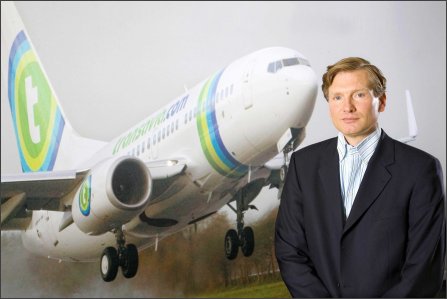By Andrea Crisp in Dublin
It’s Thursday morning in Dublin and Onno van den Brink, the chief executive of Dutch carrier Transavia, is giving the keynote address to delegates at the Airline Distribution conference organised by Airline Business and corporate credit card provider UATP
At over six foot tall, van den Brink is a commanding figure. And it is with this command that he has taken the huge step of repositioning Transavia as a travel brand rather than simply an airline. This means that instead of selling just flights, customers will be able to book their whole holiday package, including hotels, car rental, taxis, airport transfers and days out.
But this is just another step in the evolution of a company that began operations back in 1966. In 1991 Transavia’s major shareholder Nedlloyd sold its 80% holding to KLM, and today Transavia exists as an independent division of the Air France-KLM group. Its operations are optimised for low cost: it runs one type of aircraft with the maximum number of seats per aircraft. And the company also gains additional income from ancillary business, which is where Transavia’s “repositioning” is key.

So what was the logic behind the step away from being just an airline to becoming a travel brand? “It was important for us to meet the needs of the customer more extensively and by doing so become less of a commodity and thus less vulnerable,” says van den Brink. But it did not come without risk. “The first risk, which we’ve managed quite well so far, is how well our tour operators accept the move, especially if we are very successful,” says van den Brink. “There’s also the risk that it doesn’t work, and customers can’t make the mental switch from airline to travel brand. But we just have to see if it works and, if not, then we take the next step in our strategic plan.”
The new brand was launched at the end of 2004 as a consequence of the merger between Transavia Airlines and its budget arm BasiqAir. Transavia maintained its name, but took on BasiqAir’s low-cost, low-fare model and added the ancillary commodities. So with all this additional activity, how are revenues comparing with previous years? While figures for 2005/6 have not yet been released, van den Brink admits they are “far too modest”. He explains: “We are getting the organisation up and running, getting the staff. This takes time. But in the coming three years, we should have an increase in growth of 40-50% in turnover in our online shop. And while the revenue may be small, the margin will be better as the cost involved to make the products is not ours. The result is getting more and more interesting.”
But, he cautions: “That still isn’t enough to stay profitable, we still have to look at other markets and the possibility of working with other airlines.” For example, low-cost carrier Air Berlin operates services out of Amsterdam Schiphol to Berlin in direct competition with Transavia. Of Transavia’s competitors, van den Brink says: “We have to find ways to co-operate and not kill each other, for example, through codeshare agreements. There is the possibility to work together and make it more cost-efficient. For example, the cost of advertising abroad is horrendous. If we can make use of the name and distribution power of an important player abroad we could scale down enormously.”
Despite the achievement of introducing ancillary revenue streams, he warns that “we should be very cautious not to introduce methods in the way we work to make life more complicated and costly. It is essential that this [ancillary revenue] is e-driven at hardly any cost.”
With such a cutting-edge business using advanced technology, risk is part of everyday business for van den Brink. For example, Transavia uses “Capacity Space” technology, which is a few steps ahead of the competition in Holland. This allows tour operators to look at their block bookings online and respond quickly to market demands. But the newness of the technology comes at a price. “This is risky as we have to work with small partners with very specialist knowledge and we don’t know if they’ll exist in six months’ time. But it does allow us to function a few steps ahead of the competition,” says van den Brink.
As a low-cost carrier, the internet is important to Transavia. Ninety percent of bookings are made via the internet and the company invests a lot of money on advertising on the web, and in search engines such as Google. It is also more expensive for a customer to book via Transavia’s call centre, acting as an incentive to booking on the internet.
On a personal note, van den Brink seems happy in his role as chief executive. “I will stay as long as we can keep our entrepreneurial behaviour. As long as we have the possibility to think for ourselves, then I’m happy. We can and should do innovative things,” he says. He also seems content with his life away from work. When not running Transavia, van den Brink lives with his wife and three children just east of Amsterdam where he can ride horses and “drag hunt” – the humane alternative to fox hunting.
The conclusion of van den Brink’s keynote speech refers to the extinction of the dinosaur. It’s a popular metaphor for business, but a good one. In order for “the Dutch carrier with European ambitions” to survive, it must “adapt fast to changing market circumstances”. “I like that we are not looking for risks but we take steps with those calculated risks,” he says.
Click here for more Airline Business interviews
Source: Airline Business



















